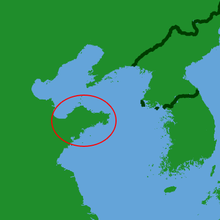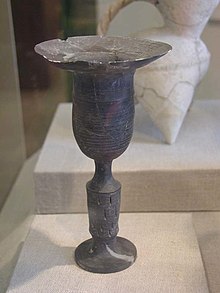Shandong Peninsula
This article needs additional citations for verification. (September 2014) |
This article may be expanded with text translated from the corresponding article in Chinese. (September 2021) Click [show] for important translation instructions.
|
| Shandong Peninsula | |||||||
|---|---|---|---|---|---|---|---|
 Location of the Shandong Peninsula | |||||||
| Simplified Chinese | 山东半岛 | ||||||
| Traditional Chinese | 山東半島 | ||||||
| |||||||
| Jiaodong Peninsula | |||||||
| Simplified Chinese | 胶东半岛 | ||||||
| Traditional Chinese | 膠東半島 | ||||||
| |||||||
The Shandong Peninsula or Jiaodong Peninsula is a peninsula in Shandong in eastern China, between the Bohai Sea to the north and the Yellow Sea to the south. The latter name refers to the east and Jiaozhou.[1]
Geography[]
The waters bordering the peninsula are Laizhou Bay to the northwest, which opens into the Bohai Sea to the north, which in turn passes through the Bohai Strait to the northeast into the Yellow Sea to the east and south. The peninsula's territory comprises three prefecture-level cities of Shandong: Qingdao in the southwest, Yantai in the north and centre, and Weihai at the eastern tip.
Geologically it was once connected to the Korean Peninsula and the Liaodong Peninsula, but was split starting around 27 Ma ago, resulting in the formation of the Yellow Sea.[2]
History[]

In the Paleolithic, the Shandong Peninsula area was covered by forest. In the Neolithic, about 7,000 years ago, a large number of Dongyi people inhabited the peninsula. The peninsula later belonged to the Shang dynasty. The State of Qi built the Great Wall of Qi, which is partially on the peninsula. The Kiautschou Bay Leased Territory was a leased territory of the German Empire from 1898 to 1914 located around Jiaozhou Bay, where the village of Qingdao (Tsingtao) developed into a major seaport.

Japan seized the territory from Germany in 1914 in the First World War. In the 1919 Treaty of Versailles, Germany lost Qingdao and its sphere of influence in Shandong. Instead of restoring Chinese sovereignty over the area, the treaty transferred the leased territory to the Empire of Japan. This resulted in popular dissatisfaction with the outcome, known as the Shandong Problem, and led to the May Fourth Movement. Eventually, Shandong was reverted to Chinese control in 1922 after mediation by the United States during the Washington Naval Conference. However, Japan retained economic influence in the area.
Due to geographical reasons, the Shandong Peninsula is closely connected with Northeast China and South Korea. Historically, a large number of people migrated to the Northeast by boat, whereas in the present day many people from the Northeast "return" to the Shandong Peninsula. After the People's Republic of China established diplomatic relations with South Korea in 1992, a large number of South Korean companies also set up factories in the region. There are more than 200,000 Koreans living in the Shandong Peninsula. South Korea has a consulate-general in Qingdao .
Major urban areas[]
| City | Area (km²) | Population[3] | Notes |
|---|---|---|---|
| Qingdao | 11,175.30 | 10,070,000 | |
| Weifang | 16,004.89 | 9,386,700 | |
| Yantai | 13,746.47 | 7,102,100 | |
| Rizhao | 5,347.99 | 3,084,500 | |
| Weihai | 5,697.98 | 2,906,500 |
See also[]
References[]
- ^ "Shandong". ChinaCulture.org. Ministry of Culture. Archived from the original on 13 February 2014. Retrieved 17 May 2014.
- ^ Niu, Yaoling; Tang, Jie (1 July 2016). "Origin of the Yellow Sea: an insight". Science Bulletin. 61 (14): 1076–1080. doi:10.1007/s11434-016-1113-z. ISSN 2095-9281.
- ^ 2020 census
Coordinates: 37°N 121°E / 37°N 121°E
| Wikimedia Commons has media related to Shandong. |
- Peninsulas of China
- Landforms of Shandong
